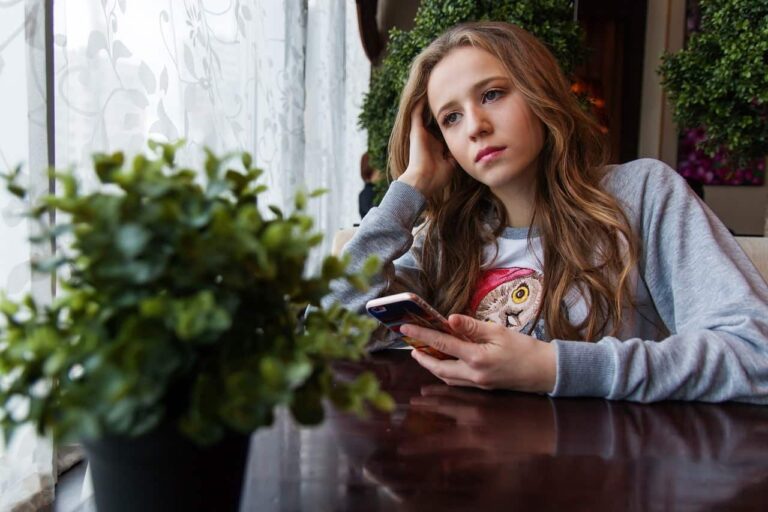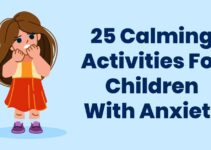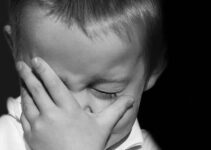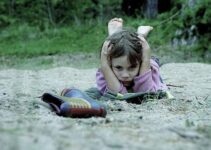If you have an anxious child or teen, you may wonder where their anxiety is coming from. The short answer is: fear. Psychologists have found that most anxiety stems from fear and the way our brains process this emotion as we grow and develop. And while fear is the body’s response to either an actual or imagined threat, anxiety is the expectation of a threat without knowing it is present.[5]
So Let’s Talk About Fear
Fear is a very common and necessary emotional state and one that children and adolescents often experience. For example, a child may feel scared:
- When their mom or dad leaves the room
- When they interact with unknown people or animals
- When they hear loud or unexpected sounds
- When they imagine make-believe scary things (like monsters or ghosts)
- When they encounter real frightening situations like a burglary, injury, accident, or other devastating event.
The world is novel and strange to them at first, and, as a result, children spend a lot of time in a state of unease — they don’t know what to expect yet.
By adolescence, children may have outgrown some of these fears, but experience the same feeling in situations such as:
- Doing poorly in school
- Talking about personal feelings or problems
- Peer-pressure situations or not fitting in with a peer group
- Worries or fears about conflict at home.
At different developmental periods, fear is appropriate in all of these situations, at least for a moment. But, what about when this fear surpasses the typical duration or when it increases in severity? What about when the child’s fears seem to be unavoidable or unable to be overcome, no matter how many times a child interacts with the fear trigger?
Table of Contents
- When Fear Works Against You Instead of FOR You
- What’s Normal Fear and Worry, and What’s Not?
- When Fear Becomes Anxiety and May Require Professional Assistance
- What Conditions May Arise From Excessive Worry and Anxiety?
- What Can Increase a Child’s Anxiety?
- How Can I Help My Child?
- What Can I Expect in the Future?
- What to Expect When Seeking Help
When Fear Works Against You Instead of FOR You
Psychologists have long studied fear and identified it as one of humankind’s primary emotions, and one that has helped us evolve throughout time[1, 2, 3]. Fear helps to protect us, generally keeping us safe and away from situations that threaten our lives. When a person perceives a threat, the body sends a response, signaling danger.
This sense of fear will initiate a natural behavioral reaction designed to help a person escape from whatever is triggering them to feel unsafe. Theorists like Dr. Robert Plutchik suggest that this response was maintained throughout evolution because of its effectiveness in keeping people out of harm’s way[4].
The problem, however, is that somewhere along the way our brains began receiving the “danger” signal way too often, or at times when it is not necessary. This causes children and adults alike to develop oftentimes irrational and uncontrollable fears, which is anxiety.
[pullquote align=”normal”]While fear is the body’s response to either an actual or imagined threat, anxiety is the expectation of a threat without knowing it is present. [/pullquote]
Let’s look at why kids begin exhibiting signs of anxiety, and how to distinguish between typical fearful/worried behaviors and anxious symptoms that may require professional support from a mental health specialist.
What’s Normal Fear and Worry, and What’s Not?
There are typical fear-related developmental milestones that most children experience that do not necessarily indicate concerns for development of an anxiety disorder. Here is a list of common worries for children throughout their development and what professionals consider typical for their age:
Normal Child Fear/Worries
- Infancy to 5 years old
- Separation Anxiety: Fear of being away from primary caregivers or being away from home. Also may be related to sleeping alone or away from caregivers, as well.
- Animals: Usually dogs or other larger animals
- Loud/Unfamiliar Noises: Banging, loud music, sirens, tires screeching, thunder, etc.
- 5 to 7 years old
- The Dark: Kids can express this earlier, but being afraid of the dark is a common fear for many children.
- Nightmares
- Monsters: Scary imaginary threats like monsters, ghosts, etc.
- Insects/Rodents
- Natural Events: Thunder, Lightning, Storms, Hurricanes, Earthquakes, Fires, etc.
- Unpredictable Events: Real-life unexpected events where something scary happens, such as burglaries, accidents, injuries, etc.
- 7 to13 years old
- Nightmares
- Insects/Rodents/Animals
- Natural Events: Thunder, Lightning, Storms, Hurricanes, Earthquakes, Fires, etc.
- Unpredictable Events: Real-life unexpected events where something scary happens, such as burglaries, accidents, injuries, etc.
- Social Issues: Social anxiety, presenting or performing in front of an audience, making new friends, etc.
- 13 years old and older
- Nightmares
- Insects/Rodents/Animals
- Natural Events: Thunder, Lightning, Storms, Hurricanes, Earthquakes, Fires, etc.
- Unpredictable Events: Real-life unexpected events where something scary happens, such as burglaries, accidents, injuries, etc.
- Social Issues: Social anxiety, presenting or performing in front of an audience, school/educational difficulties, personal relationships, career/life choices, etc.
All these fears are things that are either short in duration (meaning they are not in a state of fear for long and are able to resume their normal day-to-day life) or can be lessened with increased exposure to the trigger.
For example, if a child is afraid of a dog when they first arrive at a home, but is able to acclimate to the dog while being in proximity, this is a typical fear response.
If a child generally becomes fearful and upset when separating from a parent, but they are able to become used to spending time away from them with gradual practice, this is also typical.
**Note: While these are considered typical patterns of fear, worry, or anxiety in children, using the tips in the “How Can I Help My Child?” section below can help you support your child to conquer those fears.
When Fear Becomes Anxiety and May Require Professional Assistance
More extreme fears and worries may indicate that your child needs some assistance from a mental health professional to help them overcome these struggles, Here is a list of behaviors related to fear and worry that are more extreme in nature:
- Excessive, irrational fear to safe things, people, or experiences. This could be exhibited with a variety of behaviors, including tantrums, crying, or refusal to participate or be around the fear trigger well beyond the age that most kids have grown out of this fear.
- Excessive shyness, difficulty meeting new people, refusing to speak to unknown people.
- Clingy behavior, neediness, inability to separate from trusted others.
- Skin/hair picking, chewing fingernails/skin, etc.
- Poor sleep hygiene
- Not being able to fall asleep, not staying asleep, or waking a lot at night.
- Extreme and persistent nightmares, or night terrors (being partially awake and experiencing significant fear involving screaming, kicking, panicking, etc.).
- Feeling tired/groggy/irritable due to lack of sleep.
- Difficulties with unexpected events: Some children have difficulty with new experiences and crave predictability due to experiencing anxiety with change. This may be related to routines, transitions in activities, and even clothing or food choices.
- Health concerns
- Some children who are experiencing symptoms of anxiety will complain about a lot of medical symptoms (stomach ache, headaches, other illnesses, etc.), but no medical diagnosis is found. Many children have physical responses to feeling nervous and end up developing a connection between their mental and physical health.
- Being overly concerned about getting sick or being exposed to germs or toxins cause children to develop repetitive precautionary symptoms like over-washing hands, or developing routines to make sure they don’t get hurt or sick (having to turn lights on and off a certain number of times, saying a certain thing over and over again, etc.). These kinds of symptoms appear when kids begin to believe that if they do not do these rituals or routines that something bad will happen as a result.
- Tense/sore body, muscle aches
- Feeling confused and foggy
- Panic attacks: Experiencing an inability to breathe, rapid heart rate, chest pain, dizziness, weakness, numbness, sweaty or chills, loss of control, feeling like they could die [6].
- Safety fears: Being unable to feel safe and always worried that something or someone is going to hurt them. This can also relate to being worried about the wellbeing of others and that if they leave them, something may happen to their loved ones.
- Social fears
- Refusal to leave home or difficulty engaging in social activities including school, extra curriculars, or even play dates with other children.
- Irrational fears that peers may not like them, may bully them, or that they may do something embarrassing in front of peers (often incorporated with panic attacks).
- Academic/performance fears
- Excessive worry about performing poorly on school tests, homework, and exams.
- Difficulty with perfectionism and refusing to let finished work be complete, due to severe worries that it is not good enough.
- School avoidance or refusal due to feeling anxiety about attending or participating in the classroom, homework, or other activities.
What Conditions May Arise From Excessive Worry and Anxiety?
There are many different types of diagnosable anxiety conditions based on the symptoms the child presents, and their presence for at least 6 months.
1. Separation Anxiety Disorder
Excessive difficulty separating from home or primary caregiver.
2. Selective Mutism
A child’s inability to speak or communicate with others in specific social settings (usually school). This is not related to a child’s physical or neurological inabilities, but rather a severe discomfort in some situations. These children talk freely when they are in comfortable situations but cannot speak or communicate in other, less comfortable settings.
3. Specific Phobia
Irrational and excessive fear of a specific object, situation, or species. Anything from fear of spiders to fear of heights can be considered a specific phobia.
Severe fear of being judged, mocked, or humiliated in public settings causing a child to refuse to participate in social functions.
5. Panic Disorder
Experiencing panic attacks, and a fear of having another one (fear of losing control of preventing another attack from occurring). A child with panic disorder often avoids places or situations in fear of having a panic attack in that setting.
6. Agoraphobia
Excessive and irrational fear of leaving a place a person sees as safe and secure in fear that they will not be able to escape a life-threatening circumstance, or that they would not be able to receive help if something went wrong.
7. Generalized Anxiety Disorder
Persistent and continuous worry and fear about a variety of different things. Childen with generalized anxiety disorder generally expect bad things to happen and may exhibit a lot of avoidance of anything they feel could “go wrong.” These kids are usually overly concerned and ruminate (over-think) about everyday things in their life while worrying that they could go wrong.
8. Obsessive Compulsive Disorder (OCD)
Experiencing uncontrollable, reoccurring thoughts and behaviors that a child has the urge to repeat in an effort to remain healthy or safe (hand-washing, saying words, etc).
What Can Increase a Child’s Anxiety?
While this list isn’t exactly a list of causes of anxiety, any of these things can serve as stressors that impact a child’s ability to gradually grow out of their fears, and may increase the likelihood that they begin to expect that a threat is coming.
1. Anxious Parents
Children who live with parents who are anxious are more likely to learn the patterns of being excessively worried and expecting the worst, both from genetics (nature) and parenting (nurture). Parental stress is something that kids can absorb very quickly and can influence the way they see the world.
2. High Conflict Family Life
Difficulties managing relationships or emotions in general in the home can increase a child’s fears, worries, and stressors, thus increasing the likelihood of a child experiencing anxious symptoms. Authoritarian parenting styles — militant, strict, and overly negative parenting — can also increase a child’s symptoms of anxiety.
3. School & Peer Struggles
Experiencing bullying or other negative peer interactions, or generally feeling like you don’t fit in can increase a child’s difficulty with managing negative thoughts and negatively predicting the future, often increasing anxious symptoms.
4. Trauma
Any major distressing event — including natural disasters, abuse/neglect, injury, illness, etc. — involving the child or someone close to them can have a major effect on a child’s ability to feel safe, thus impacting his or her ability to overcome fear associated with things that remind them of these experiences.
Click HERE to read more about trauma
How Can I Help My Child?

Every child has fears., The parent’s job is to be supportive and empathetic about these fears, but also to challenge children to overcome their fears when they appear irrational and excessive. Here are some suggestions to help your child improve their ability to be brave and overcome their fears:
1. Connect, Re-State, Redirect
- Connect: Being supportive and validating of your anxious child is very important when they are scared… but you want to validate the child and not the fear. You can connect with your child and validate that they are feeling scared with a simple statement:“I can tell that you feel worried about that.” Sometimes, giving some behavioral descriptions or identifying what their body is doing to clue you into their nervousness can be helpful: “I can tell you’re anxious because you are gripping my arm and your body looks tense and worried.”
- Re-state: Anxious kids often have a voice in their head forcing them to expect the worst in each scenario. Once you validate their feelings, it’s important not to validate the fear itself. You can do this by asking what they’re thinking about and challenging the thought in a gentle way. I like to do this with the children I work with by asking for evidence for their thought. “Is it TRUE that you are terrible at soccer? Because I saw you score two goals last week. What evidence do you have that you’re bad at soccer?”
- Redirect: Another strategy is to help your child develop an alternative thought to replace a negative or inaccurate thought that comes with a faulty expectation. “Try thinking about how good it felt when you scored those two goals! Now you can remind yourself that even though you had a tough game today, you are a good soccer player and can always practice and get better!”
2. Teach Them To Relax
Anxious children can generally feel tense and their bodies hold a lot of negative energy, thus increasing the odds that their thoughts will gravitate toward negative expectations. To help with this, you can help your child relax with a couple simple strategies:
- Stretching, yoga, progressive muscle relaxation: All of these activities can help children tense and relax their muscles to make their bodies feel more calm, thus helping their mind to do the same.
- Deep breathing: Eliminating toxic air and filling your lungs with healthy, clean air helps to regulate heart rate and helps to make children feel calm and relaxed.
- Grounding: Distraction techniques designed to get a child to think about the present moment and not what is making them feel anxious (*this is key during a panic attack):
- Ask your child to identify all the colors they see in the room.
- Ask your child to tell you about all their favorite foods, movies, colors, or places, etc.
- Ask your child to identify things with their senses (five things they see, four things they hear, three things they feel, two things they smell, one thing they taste).
- Mindfulness: Guided imagery, meditation, and other forms of keeping a child in the present moment can also be effective in helping improve relaxation skills.
3. Set Boundaries and Expectations
Keeping things simple and clear for anxious kids is of utmost importance. If your child is experiencing severe anxiety, it’s important to have goals in mind for helping them challenge their fears gradually, while also considering that they may need time away from the hustle and bustle of weekend activities and play dates to be able to do that. Having clear expectations surrounding what you will participate in, for how long, and when to call it quits and give your child the ability to utilize relaxation skills is key.
4. Get Help from a Professional
A mental health professional is skilled in all of these areas and will provide you and your child with personalized ways to help your child overcome their fears and symptoms of anxiety. They will also develop strategies to help your child become braver in a loving and effective way.
What Can I Expect in the Future?
Some children grow out of symptoms of anxiety and others develop more chronic and life-long difficulties. If your child is exhibiting some of the severe symptoms, seeking professional help early is the best step to help a child catch their negative thought patterns and excessive worry before it becomes a more developed and long-term pattern.
It can be so distressing to see a child scared and upset — sometimes just having another person on your team trying to help them overcome their fears and worries can help a parent feel more supported, as well.
What to Expect When Seeking Help
Mental health professionals who specialize in anxiety with children generally take a cognitive behavioral therapy (CBT) approach, where they help a child to recognize the way they think and how it affects their feelings, emotions, and behavior.
It’s generally suggested that children under five participate in a family treatment model where parents learn the skills they need to help a child challenge their fears in a healthy way.
Older children can participate with a therapist alone and learn the skills they need to challenge their negative automatic thought patterns and feel less scared and nervous about whatever is triggering them. Often this kind of work can be supplemented by medication support with a psychiatrist or general practitioner, though this is not necessary for every case.
Overall, anxiety is treatable by all who work in mental health, and once you get a team together to discuss your goals for improving your child’s anxiety symptoms, real, lasting change can begin.
References
- James, William (1 April 2007). “The Principles of Psychology”. Cosimo, Inc. Retrieved 10 December 2018 – via Google Books.
- Crain, W. (2010). Theories of development: Concepts and applications, 6th ed. Upper Saddle River, NJ: Prentice Hall.
- Handel, Steven. “Classification of Emotions”. Retrieved 10 December 2018.
- Plutchik, Robert (16 September 1991). “The Emotions”. University Press of America. p. 110. Retrieved 10 December 2018– via Google Books.
- American Psychiatric Association. (2013). Anxiety Disorders. In Diagnostic and statistical manual of mental disorders (5th ed.). Washington, DC: Author.
- Panic Attack Symptoms. (n.d.). Retrieved from WebMD










